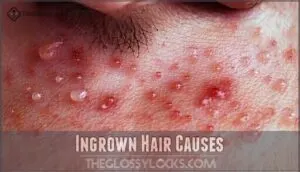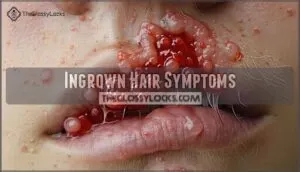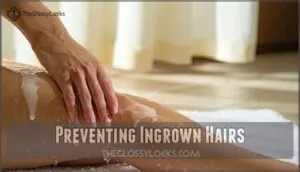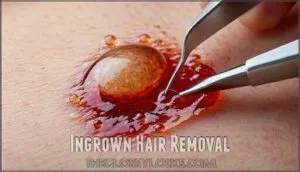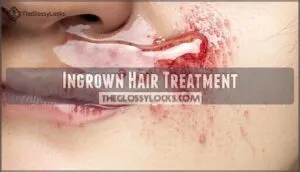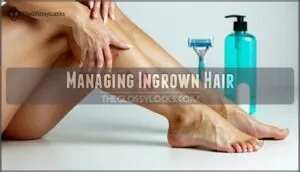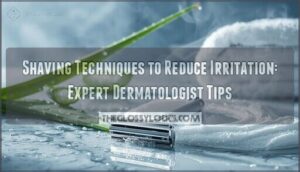This site is supported by our readers. We may earn a commission, at no cost to you, if you purchase through links.
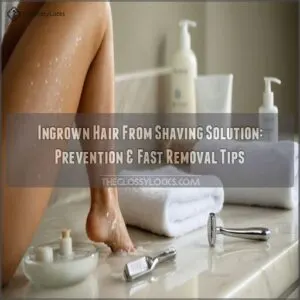
When you’re ready to resume, wash with a medicated soap containing salicylic acid, glycolic acid, or benzoyl peroxide to prevent trapped hairs. Exfoliate gently before shaving and always use a sharp razor with the grain.
For existing ingrowns, apply warm compresses to coax them out. Don’t pick! Twenty minutes with a warm washcloth works wonders where fingers fail. Your smooth skin journey extends beyond just the right products, and remembering to take a break and use the right technique is critical.
Table Of Contents
Key Takeaways
- You’ll need to give your skin a break from shaving for up to 30 days to help heal ingrown hairs and prevent new ones from forming.
- Always shave with the grain using a sharp razor and gentle pressure to reduce the risk of hairs curling back into your skin.
- Exfoliate regularly with products containing glycolic or salicylic acid to remove dead skin cells that can trap hairs beneath the surface.
- Apply warm compresses to existing ingrown hairs for 20 minutes to coax them out naturally instead of picking at them, which can cause infection and scarring.
Ingrown Hair Causes
Ingrown hairs happen when shaved or removed hair grows back into the skin instead of outward, often causing redness and irritation.
This can occur due to improper shaving, tight clothing, or naturally curly hair that tends to curl back under the surface.
Hair Growth Patterns
Understanding hair direction and follicle shape is key to preventing ingrown hairs.
Curly hair, due to its unique structure, grows downward or even curls back into the skin.
Growth rate and thickness also play a role, as thicker hairs are more prone to piercing skin.
Natural shedding sometimes fails, trapping hair, and proper care promotes healthy hair growth and reduces issues, which is crucial for preventing ingrown hairs and ensuring proper care.
Shaving Techniques
A good shaving solution starts with razor sharpness and lubrication importance.
Always shave directionally—with the grain—to reduce razor bumps. Pre-shave prep, like warm water and gel, softens hair for smoother glides.
Stick to shaving techniques, like gentle strokes and cleaning blades often, to avoid trapping hair.
Post-shave care calms skin, keeping irritation and ingrown hair at bay.
Skin Types and Conditions
Not all ingrown hairs are created equal—your skin type plays a big part.
- Sensitive skin feels the burn, leading to redness and irritation.
- Dry skin traps hairs, making shaving tricky.
- Oily skin clogs pores, increasing bumps.
- **Acne-prone?
** Expect flare-ups.
- Combination skin juggles all the above.
Tailor your shaving solution to your skin conditions for fewer tangled hairs.
Hair Removal Methods
Shaving tips matter, but hair removal methods vary in effectiveness.
Waxing benefits include smoother skin but risks ingrown hairs; threading details reveal irritation risks.
Cream alternatives and sugaring methods offer gentler options.
Electrolysis options may prevent ingrown hairs long-term.
One key to prevention is regular skin exfoliation, which can be found at regular skin exfoliation.
| Method | Risk of Ingrowns | Maintenance Needed | Skin Types | Cost |
|---|---|---|---|---|
| Shaving | High | Frequent | All | Low |
| Waxing | Moderate | 4–6 weeks | Most | Moderate |
| Threading | Moderate | 2–4 weeks | Sensitive | Low |
| Sugaring | Low-Moderate | 4 weeks | All | Moderate |
| Electrolysis | Low | Minimal (after sessions) | All | High |
The table summarizes the key points of each hair removal method, including the risk of ingrowns, maintenance needed, suitable skin types, and the associated cost, providing a clear comparison of options like shaving, waxing, and electrolysis.
Ingrown Hair Symptoms
When you get an ingrown hair, it often shows up as a red, itchy bump that can look like a small pimple.
Those tiny red bumps aren’t just annoying—they’re your skin’s SOS signal after a hair takes a wrong turn.
Sometimes, it hurts or even fills with pus, making shaving feel more like a chore than a routine.
Redness and Inflammation
Sometimes, shaving leaves behind red bumps and irritated skin—clear signs of inflammation.
Ingrown hairs trigger redness by curling back into the skin, sparking irritation.
To calm skin inflammation and prevent infection, use soothing ingredients like aloe or tea tree oil.
For redness relief, apply a cool compress, and remember, avoiding post-inflammatory hyperpigmentation means treating skin gently while moisturizing after every shave.
Itching and Discomfort
Why does shaving sometimes make your skin crawl? Ingrown hairs can cause relentless itching and discomfort, especially in sensitive areas.
To manage this:
- Use soothing lotions for irritation relief.
- Avoid tight clothing to reduce friction.
- Sleep in breathable fabrics to minimize skin irritation.
- Apply warm compresses to calm itching.
Small steps make a big difference in pain management and can help with relentless itching, and using soothing lotions can provide irritation relief.
Bumps and Pus
Pus bumps from ingrown hair feel like small, painful surprises.
These pimple-like bumps form due to bacterial infections, often appearing red and swollen. Infection signs, like pus formation, signal trouble if ignored.
Bump types vary, but managing pain early prevents skin infection or scarring risk.
Cleanse gently and apply warm compresses to ease discomfort and help healing.
Scarring and Hyperpigmentation
When ingrown hairs heal, they sometimes leave scars or dark spots, known as hyperpigmentation. This discoloration often appears more noticeable on darker skin tones.
To minimize these effects, practice good skincare habits:
- Apply skin discoloration treatment with ingredients like vitamin C or retinol.
- Use sunscreen daily.
- Avoid picking ingrown hairs.
- Try professional skin scarring treatment.
- Focus on prevention methods.
By following these steps, individuals can reduce the appearance of scars and dark spots, promoting healthier and more even-toned skin.
Preventing Ingrown Hairs
Preventing ingrown hairs starts with taking care of your skin and adjusting your hair removal habits.
By exfoliating regularly, using sharp razors, and shaving gently with the grain, you can reduce irritation and keep hairs from curling back into the skin, which is a key step in preventing ingrown hairs and irritation.
Exfoliation and Skincare
Bumps and itching? Exfoliation is your best friend for preventing ingrown hairs.
Use products with glycolic or salicylic acid twice weekly to clear dead skin and reduce irritation.
Physical exfoliation works too, but gently—no scrubbing like you’re washing a car!
Follow with moisturizing to protect your skin barrier and soothe inflammation.
You can purchase a glycolic acid exfoliant online. Product selection matters—stick with non-comedogenic options.
Shaving With The Grain
To reduce ingrown hairs, always follow the hair direction while shaving.
Aim for gentle strokes and avoid pressing too hard.
These tips help:
- Use a proper razor angle to prevent cuts.
- Avoid pulling the skin tightly, which traps hairs.
- Limit your shave frequency to let skin heal.
- Practice effective shaving techniques for smoother results.
Using Sharp Razors
A sharp razor is your best friend against ingrown hairs and razor bumps.
Dull blades tug at hair, irritating skin and increasing risk. Maintain razor sharpness by replacing blades frequently and storing them dry to prevent rust.
Use light shaving pressure and proper blade angles to glide smoothly over sensitive areas. Sharp razor blades enable precise shaving techniques, minimizing irritation.
Proper exfoliation helps remove dead skin to prevent ingrown hairs, and using a sharp razor is crucial for this process, as it allows for a closer shave without causing razor bumps.
Avoiding Tight Clothing
Snug clothes might look stylish, but they’re no friend to your skin after hair removal.
Tight clothing increases friction, irritates sensitive areas, and traps sweat, leading to ingrown hair.
Choose breathable fabrics to improve circulation and reduce friction.
After exercising, always swap out sweaty wear promptly—your skin will thank you.
Loose, comfy clothes are key to preventing ingrown hairs effectively.
Ingrown Hair Removal
Getting rid of ingrown hairs doesn’t have to be complicated if you know the right steps.
From warm compresses to professional treatments, you’ve got options to tackle these stubborn bumps effectively and safely.
Warm Compresses
Warm compresses work wonders for soothing ingrown hair and calming skin irritation.
Grab a clean cloth, soak it in warm water (not scalding!), and gently press it to the area.
This softens the skin and hair, easing inflammation.
- Use tea tree oil or chamomile water for soothing additives.
- Apply 3-4 times daily for relief.
- Prevent infection by ensuring compress materials stay clean.
Tweezing and Plucking
Using tweezers for ingrown hair removal can be tricky but effective.
Opt for sterile tools to avoid infections.
Gently lift the hair piercing the skin without plucking too deep.
Follow with plucking aftercare like applying an antiseptic.
Pain management helps—try a warm washcloth before starting.
For regrowth prevention, exfoliate regularly to keep those hairs from curling back under.
Consider laser hair removal for a more permanent solution.
Chemical Exfoliants
Chemical exfoliants like glycolic acid, salicylic acid, and lactic acid prevent ingrown hairs by clearing dead skin.
These AHA/BHA benefits include smoother skin and less inflammation.
Sensitive skin? Stick to mild exfoliating products to avoid chemical over-exfoliation. For those seeking such products, shop related items.
Try product combinations with anti-inflammatory ingredients for balance. Use consistently but sparingly to keep hair from trapping and to avoid irritation.
Professional Hair Removal
When chemical exfoliants don’t cut it, professional hair removal offers long-term solutions.
Options include:
- Laser Hair Removal: Targets follicles, but laser downsides include cost and skin type limits.
- Electrolysis: Permanent results; electrolysis benefits those with stubborn ingrown hairs.
- Intense Pulse Light (IPL): Gentle with fewer threading concerns.
Consult laser therapists, dermatologists, or try sugaring advantages over waxing alternatives.
Ingrown Hair Treatment
Treating ingrown hairs is simpler than you might think, and it starts with reducing irritation and promoting healing.
From medicated creams to advanced therapies, there are effective solutions to help your skin recover quickly, using methods that are often simple.
Antibiotics and Antifungals
Sometimes, ingrown hairs lead to bacterial infections or fungal involvement, making antibiotics or topical antifungals essential.
Topical antibiotics can treat minor skin infections, while oral antibiotics may help severe cases. Remember, antibiotics overuse risks resistance, so follow medical advice.
For fungal cases, topical antifungals work well. Prompt treatment stops pain and prevents worsening.
Consult a doctor if issues persist.
Corticosteroids and Hydrocortisone
If skin inflammation worsens, topical steroids like hydrocortisone calm redness and swelling quickly.
These steroid creams vary in potency levels, so follow prescription medications closely. Apply thin layers on irritated spots, but don’t overdo it—side effects include thinning skin.
Knowing the available cream strengths is important for effective treatment. Pediatric use requires extra caution; consult your doctor for safe application methods.
Hydrocortisone offers fast relief when ingrown hairs irritate sensitive areas, providing fast relief and helping with sensitive areas.
Laser and Light Therapy
While topical treatments help manage symptoms, laser and light therapy offer lasting solutions for persistent ingrown hairs.
Red light therapy increases blood flow to inflamed areas, while blue light therapy‘s effects are among the most well-documented in photomedicine.
Both treatments reduce skin friction and strengthen your skin’s natural defenses.
For permanent results, consider laser hair removal options like Gentlemax PRO or Ulike Air 10, which safely treat all skin types, providing a lasting solution.
Managing Ingrown Hair
You’ll need a strategic approach to manage those pesky ingrown hairs that appear after shaving, focusing on reducing irritation and maintaining skin health.
By spacing out your shaving sessions and establishing a consistent skincare routine with gentle exfoliation, you can substantially reduce your battle with those stubborn trapped hairs, and this approach will help in maintaining overall skin health by reducing irritation.
Reducing Shaving Frequency
Struggling with persistent ingrown hairs? Reducing your shaving frequency may be the solution you’ve been looking for.
Your hair growth cycles need recovery time between sessions. Consider adopting alternative styles like maintaining short stubble or embracing longer hair in problem areas.
Adjusting your grooming habits to shave every 3-4 days instead of daily gives your skin time to heal and prevents trapped hairs from forming, allowing for a more effective approach to managing ingrown hairs and promoting overall skin recovery.
Avoiding Irritation
Consistently treating your skin with care prevents the angry rebellion of ingrown hairs.
Use gentle cleansing products without fragrance, avoiding harsh soaps that strip natural oils. Wear soft fabrics that won’t rub against freshly shaved areas.
Apply hydrating balms with calming ingredients after shaving. Before trying new products, perform patch testing—your sensitive skin will thank you for preventing those painful bumps that appear when shaving techniques go wrong.
Regular exfoliation helps prevent hair getting trapped. Consistently using gentle cleansing products and applying hydrating balms can make a significant difference, and it’s crucial to avoid harsh soaps.
Maintaining Healthy Skin
Beyond avoiding irritation, maintaining healthy skin is your best defense against pesky ingrown hairs.
Daily moisturizing keeps your skin barrier strong, while gentle cleansing removes buildup without stripping natural oils.
For ideal postshave care:
- Drink 8-10 glasses of water daily to boost hydration levels
- Eat a balanced diet rich in skin-supporting vitamins A, C, and E
- Apply broad-spectrum sun protection, as sun damage worsens ingrown hair problems to ensure overall skin health.
Frequently Asked Questions (FAQs)
When should I see a dermatologist?
Those red angry spots tell a tale.
See a dermatologist if your ingrown hairs become infected, don’t heal within 2-3 weeks, cause severe pain, or if you’re developing scars or darkened patches.
Are certain ethnicities more susceptible?
Yes, you’re more susceptible to ingrown hairs if you have curly or coarse hair.
People of African ancestry face higher risks, though all ethnicities can experience them.
Hair texture matters more than ethnicity itself, and this is a complete concept to consider when understanding ingrown hairs.
Do ingrown hairs resolve on their own?
Most ingrown hairs will resolve on their own within 1-2 weeks.
You’ll notice less irritation as the hair naturally works its way out, though some stubborn cases may require treatment to prevent infection.
Can dietary changes reduce ingrown hairs?
While no direct studies link diet and ingrown hairs, staying hydrated and eating anti-inflammatory foods rich in vitamin A and C may improve your skin’s health.
This potentially reducing your susceptibility to those pesky trapped hairs.
Are electric shavers better than razors?
Electric shavers can be better than razors for preventing ingrown hairs.
They don’t cut as close to the skin, leaving hair slightly longer which reduces the chance of hairs curling back into your skin, this can be seen as a key benefit of using electric shavers.
Conclusion
Think of your skin as a garden—when well-tended, it thrives beautifully.
Conquering an ingrown hair from shaving solution requires both patience and consistency.
Remember to exfoliate regularly, use sharp razors, and shave with the grain.
When ingrowns appear, treat them gently with warm compresses rather than picking.
By incorporating these practices into your routine, you’ll minimize irritation and enjoy smoother, healthier skin. Your body will thank you for the extra care!

